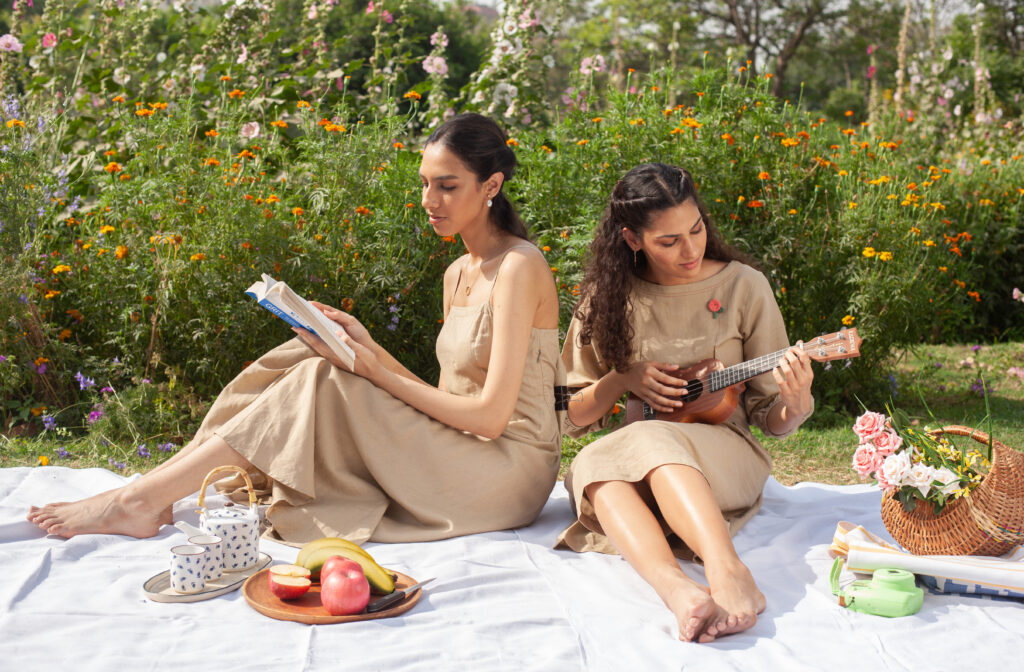
Late last year, images of Chile’s Atacama Desert flooded social media and news channels, causing an alarming concern for environmentalists all across the globe. Mounts of discarded fashion waste filled up acres of the area — from T-shirts and Christmas sweaters to boots; the place was quickly dubbed as “fast fashion’s graveyard.” Globally, approximately 92 billion tonnes of textile waste is thrown away with more than one million of it produced and dumped in India. And while fast fashion’s other sins — that of wage discrepancies and unfair labour — have been topics of great debate and scrutiny, its impact on the ecosystem as a whole is often rendered secondary.
The growing shift towards sustainable fashion, however, cannot be disregarded. Though the term “sustainable” has become more of a marketing gimmick, there are many young designers who have taken on the mantle of actually employing problem-solving fashion techniques to curb fast fashion’s disastrous effects and bring on real change. One such designer is Kriti Tula, founder of the brand Doodlage, for whom sustainability is not just a buzzword to push her brand forward but a way of life. Doodlage thrives on an upcycling model, using industry waste and rags to create ethical designs that are both environmentally conscious and wearable. Brown Girl Magazine spoke to the designer about Doodlage’s zero-waste concept, the tough terrain she had to walk on in order to establish a game-changing fashion label, and the importance of functionality in sustainable fashion:
View this post on Instagram
Tell us more about the concept behind Doodlage, the meaning behind the brand name and what it hopes to achieve.
As a designer I was always inclined to find solutions, and Doodlage started exactly with that agenda. Our aim was to start a conversation around ways to bring circularity in fashion and raise awareness around the impact of a linear fashion model.
Our brand name is a play on the word ‘doodle’ or the art of doodling. Each piece designed at Doodlage comes with additional doodles created by the artisan during the process of creation in order to fix a problem unique to his/her piece. These are a set of doodles that are designed at the sampling stage, its placement and suitability is left to each artisan to decide, making doodling a part of our design process.
What led you to start a brand around upcycled fashion?
We started collecting fabric waste from factories around Delhi, rejected for minor defects and post cutting waste, which are panels that are big enough to be stitched back together to cut more pieces. This allowed us to create short well-finished limited edition collections, saving tonnes of fabric from landfills and down-cycling. As we grew to understand various issues, scale and impact of the fashion industry, we found ourselves more committed to building a social enterprise making season-less clothes, working to provide better living wages for our artisans and using low impact raw material.
How personal is the concept of upcycling for you?
It is a concept that is deeply rooted in my system. I still remember the time when clothes were deeply cherished and handed down, repaired, up-cycled into new garments or other products before they became rugs or rags.

What were some of the creative challenges you faced while upcycling materials for your brand?
It is tough to scale upcycling. It took us a while to get a hang of how to optimise the waste sourced. What kind of waste to source to create replicable styles. How to communicate and convince consumers to trust us to send them a similar outfit each time we upcycle a product. But scale is necessary for upcycling to be a fiercer alternative for people and the planet.
What challenges did you face in your journey of establishing a brand with such a unique concept?
It took us a while to connect to mass manufacturing units and organise sources for our raw materials as it wasn’t a simple shop from store model.
These units work with massive quantities of wastage, and fabrics we pick up from each unit to upcycle are far less in proportion. It was initially quite difficult to make this worth their while. But we are glad to have reached a point where people now reach out to us to help them work with their waste.
Working with fabric waste comes with multiple challenges. From justifying the cost to the consumer and the constant question of managing price points, competing with fast fashion when you can’t over-produce to avoid inventories and dead stock. To also now looking at the credibility of each vendor with the over-popularity of green fashion. Our main struggle is to find ways to make sustainable fashion more mainstream.
Upcycling is very much a part of South Asian culture yet when it comes to fashion it’s not something people easily warm up to. How difficult was it to create space and find a market for your brand?
There is a niche that is always willing to explore alternatives, we connected with this niche very early on in our journey and our initial acceptance encouraged us to do more. Even now, 40% of Doodlage’s audience just shops for our products and sees what we do as a value add while 60% of our audience is looking for consciously-created products.
A lot has changed in the consumer mindset in the last four to five years. The environmental problems are becoming more real and millennial consumers are becoming more conscious and accepting of things that the generations before us were skeptical about.
View this post on Instagram
What is it that you particularly look for in the garment when starting your creative process?
We work mostly with factory waste. We look at how old the material is and what the defects in the material are before we source and start designing with the material.
Is it the garment or the scraps that direct the design or is it the design that sets the requirement for the garment needed?
Our creative process starts with the material we design for the material sourced, as the fall of the material and the compatibility of this waste to be stitched together affects the overall look of the final product.
What does sustainability in fashion mean to you and how important is the functionality of the outfit in this chain?
Sustainability for me is the balance between the environment, the economy and ethics. A lifestyle change needs dedication, research, perseverance outside of your comfort zone but it is rewarding in the end for everyone. The problem of pollution in the fashion industry often seems overwhelming but when endorsing sustainable fashion or lifestyle it is just important to start somewhere and take it one step at a time. Just consume consciously and make more aware choices for people and the planet.
I think functionality is key for any sustainable outfit, it’s important to push for wear and re-wear the only way for that to happen is when you are in absolute love with your outfit and are willing to find multiple ways to wear it.
What’s next for you and the brand? How do you aim to sustain and expand on Doodlage’s ethical mission?
We are working to raise funds to scale the impact of our brand. We want to be able to offer a wider product range to allow consumers to make a switch to sustainable alternatives and increase our direct-to-consumer reach in physical spaces, mostly with the right collaborations. And work to expand our B2B solutions for corporates and organisations looking to make small impactful changes in their system.
We have spent time finding solutions to work with post-production waste. Our next steps are also to create a collection system for post-consumer waste and find ways to work with that!
View this post on Instagram
Turning fabric and cutting waste into wearable, functional fashion is not the only art Tula is a master of. In fact, sustainability and zero wastage run through every aspect of Doodlage’s design process. Any leftover waste that is generated during in-house designing is utilised to make accessories whereas scraps are used to make stationery items. There is a purpose for every element otherwise meant for the dump yard. It’s no doubt that a healthier planet demands such deep-rooted sustainable practices within industries and for more millennials and Gen-Z’s to have a conscious approach to living.
Photos Courtesy: Kriti Tula




